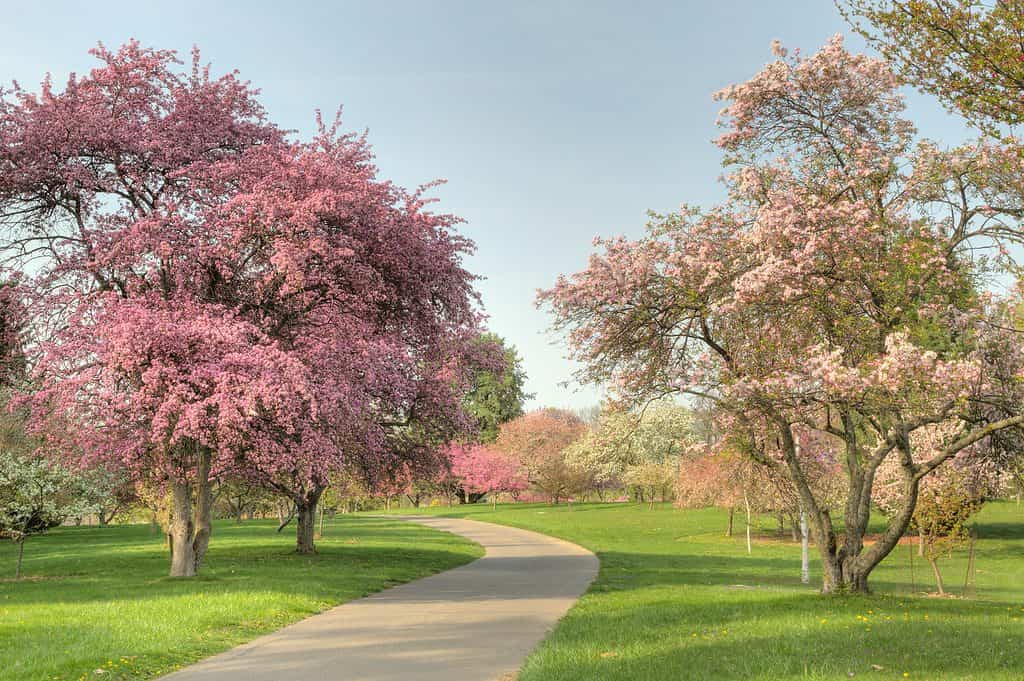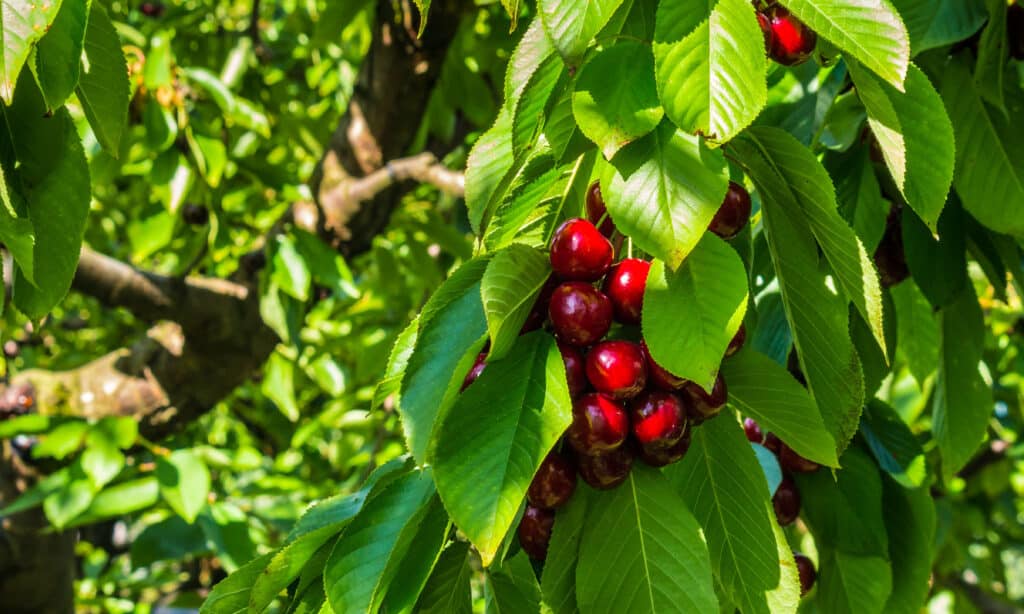Have you considered planting your very own cherry trees? There are two reasons they are grown; for their fruit and for their beautiful blooming appearance. Because of the excellent fruit they produce, cherry trees are grown around the world by commercial growers and lone gardeners. Just as well, cherry trees are occasionally planted by landscapers because they look lovely when they bloom in the spring.
Whether you want to grow these beautiful plants for their cherry fruits or simply for their ornamental value, growing cherry trees is a fairly straightforward process. In this guide, we’ll take a look at the history of cherry trees and how you can start growing your very own in your backyard or garden.
The Botanical Name and History of Cherry Trees
The botanical name for the common cherry tree, also known as the sweet cherry or wild cherry, is Prunus avium. It is a member of the Rosaceae plant family, making it closely related to a wide range of fruit trees such as the apple tree, almond tree, peach tree, and many more.
From the British Isles south to Morocco and Tunisia, north to Norway, east to the Caucasus, and northern Iran, with a tiny isolated population in the western Himalayas, the cherry tree is native to Europe, Anatolia, and Western Asia.
Humans have used wild cherries as food for thousands of years. Deposits containing the seeds of this plant have been discovered in Bronze Age towns around Europe, notably in Britain. One dated instance was the discovery of wild cherry macrofossils in a core sample taken from the debris under a pile-dwelling structure from the Early and Middle Bronze Periods.
Cherries were actively being grown in Asia Minor by 800 BCE, and Greece followed soon after. In many other places, including North America and Australia, the wild cherry is commonly farmed. It’s usually grown as a blooming tree for decorative purposes. Given its size, the tree is more often employed in parks than in gardens or on streets.
One of the two cherry species that provides the majority of the commercial cultivars of edible cherries grown across the world is the sweet cherry, which is the primary progenitor of the cultivated cherry. This is the species we will focus on for the remainder of this guide, as it is likely the type of tree you will want to plant in your garden.
There are many different cultivars of sweet cherry trees, many of which are small varieties ideal for planting in pots. The Stella, Lapins, and Piena cherry trees are some of the most well-known or intriguing varieties. Dark crimson fruits are produced by the dwarf, self-pollinating Stella cultivar. The semi-dwarf, self-fertile Lapins cultivar yields a large number of black fruits. The Piena cultivar doesn’t bear fruit; instead, it has clusters of double, falling white blooms that make it popular as a landscaping tree.

Cherry trees (pictured) are grown for both their fruits and their showy, ornamental flowers.
©Cynthia Kidwell/Shutterstock.com
Climate and Hardiness Zone Requirements for Cherry Trees
Wild cherry trees can be grown in USDA hardiness zones four through seven. Anywhere in the world where the winters are not too harsh and the summers are not too hot, cherries are able to thrive and fruit. They need the cold of winter to bloom in the spring. Just after peaches and before apples in the spring, cherry trees tend to blossom pretty early. While tart cherries will thrive in lower temperatures and require around two months of winter temperatures below 45 degrees F, sweet cherries are best suited for areas with moderate temperatures and little in the way of humidity.
When to Grow Cherry Trees
It is ideal to plant bare-root sweet cherry trees in the spring or late fall. The tree will be dormant and the soil will be less dense or frozen and naturally damp. These trees typically grow 15 to 20 inches a year, and it can take them at least seven years from the time they are planted to begin bearing fruit.
Starting Cherry Trees From Seed vs. Buying Adult Plants
Learning how to grow cherry trees from seed can provide you with stunning, fragrant blooms in the spring and wonderful fruits in late spring and early summer, even though many backyard fruit producers buy young trees from nurseries instead. Growing from seed is a considerably more affordable choice, and it’s also surprisingly easy!
Cherry trees can be grown from seeds and planted either in the spring or in the fall. To start, your cherry seeds should be placed in a dish of warm water. After letting them soak for a few minutes, carefully scrub them to get rid of any remaining fruit pulp. The seeds should be spread out on paper towels and allowed to dry for a week. Keep them in a warm spot, such as a sunny windowsill.
The dried pits should be placed in a glass jar or plastic food container with a tight-fitting cover. They will then spend the next 10 weeks in the refrigerator. This process, known as stratification, simulates the cold winter months when seeds remain dormant before spring and is important for the seeds to germinate.
The cherry pits should be taken out of the refrigerator and allowed to come to room temperature after those ten weeks. After that, you can plant them in a pot filled with potting soil. In each pot, plant two or three pits. Put them in a sunny area and water them often to keep the soil moist but not soggy. Thin seedlings after they are about two inches tall, and make sure to preserve the tallest plant. Keep them in a sunny location; if the nighttime temperature has dropped, put them close to a sunny window. They will remain there until spring when you can plant them outside once the risk of frost has gone. By then, the seedlings ought to be a few inches tall. That’s really all it takes!
How to Grow Cherry Trees
This fruit-bearing deciduous tree can grow up to a whopping 65 feet tall, so make sure your space can accommodate this tree and that it can be planted away from buildings and other structures.
Because cherry trees are self-sterile, they are typically grown in clusters in orchards so that they can pollinate one another. Recently, some self-fertile cultivars have been developed; they are perfect for growing in pots or as individual ornamental specimens.
To guarantee proper air circulation and enough sun, as mentioned earlier, sweet cherry trees should be placed at least 40 feet apart and away from other trees or buildings. Dwarf trees can be planted in pots and potted up at any time of the year, and they only need about 10 feet of space between them. Sweet cherry trees prefer to grow in sunny, protected locations with enough airflow. They thrive on deep, damp soils and dislike intense temperatures.
To promote new growth, cherry trees benefit from yearly trimming. Different gardeners and horticulturists have different ideas about when to prune. It is generally agreed upon to avoid doing any pruning in the fall. Some gardeners recommend trimming in the winter, while others think that doing so raises the likelihood that the trees will contract bacterial diseases. After the blooming season, established trees will often need early summer trimming to keep them from growing out of control.

Cherry fruits (pictured) will only grow if their trees are properly pollinated by other cherry trees.
©patjo/Shutterstock.com
Soil and Fertilizer Requirements for Cherry Trees
A sweet cherry tree will thrive in soil that is well-drained, loamy, fertile, and slightly wet. While these trees can tolerate a broad variety of pH values, they favor acidic environments. It is also well-known that cherries are heavy feeders. Up until they begin producing fruit, they will benefit from an annual spring feeding and another one in the fall. Mature trees often only require fertilization in the fall, following harvest. The most effective fertilizer is organic and nutrient-rich. Brown rot issues can be caused by an excess of nitrogen, so be sure to test your soil before planting.
Water Requirements for Cherry Trees
Due to their thin roots, cherry trees are susceptible to issues during dry spells, which is why mulching or using soil that retains moisture is advantageous. Watering will be necessary every one to four weeks, depending on how dry and warm the climate is. Throughout the growing seasons, it’s crucial to prevent the roots from entirely drying out. Sweet cherries can withstand some drought, but they cannot endure soggy soil.
Temperature and Humidity Requirements for Cherry Trees
Temperate conditions are ideal for cherry trees. The fruit on the tree can sometimes grow unnaturally if the temperature is too high. To ensure they will produce a good display of blossoms and fruit the next season, they require a lot of shade throughout the winter. However, spring buds can be harmed by late frosts and extremely low temperatures.
Sunlight Requirements for Cherry Trees
These trees prefer full sun, but in areas with intense afternoon light, it’s better to plant them where they will have some partial shade so they can receive some relief from it.
How Long Do Cherry Trees Take to Be Ready for Harvest?
When it comes to picking your delicious cherries, timing is everything. If you pluck them too early, they won’t be as sweet as they should be, and if you pluck them too late, they’ll be too soft. The fruit’s sugar content significantly rises during the final few days of ripening.
Sweet cherries need to reach their full color and be tasted before harvesting since they do not fall from the stem as easily as sour cherries do when they are ripe. Don’t be tempted to take cherries from the tree too soon since they stop ripening once they are off the tree. If at all possible, harvest the fruit before any significant downpours since rain might cause the fruit to split.
Cherry Tree Companion Plants
As always, you should only choose companion plants for your cherry tree that matches its water, soil, temperature, and humidity needs. A few excellent herbs that can repel pests from your cherry tree include rosemary, dandelion, marjoram, and caraway. Trees like pears and persimmons don’t attract many pests and grow in similar conditions to cherry trees.
If you have enough space to accommodate these often massive trees, growing cherry trees is actually very easy (and fun!) to do. Just make sure your trees get enough sun, plenty of water, and a little bit of ongoing TLC to produce delicious, juicy cherries.
The photo featured at the top of this post is © patjo/Shutterstock.com
FAQs (Frequently Asked Questions)
Where should cherry trees be planted?
Cherry trees should be planted somewhere they can receive full sun and excellent air circulation.
How long do cherry trees take to grow?
Cherry trees take around five years to grow.
Can cherry pits be used to grow trees?
Yes. The pit is the seed of the cherry.
Thank you for reading! Have some feedback for us? Contact the AZ Animals editorial team.







